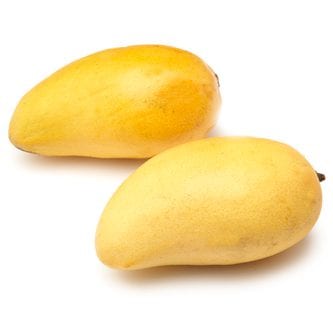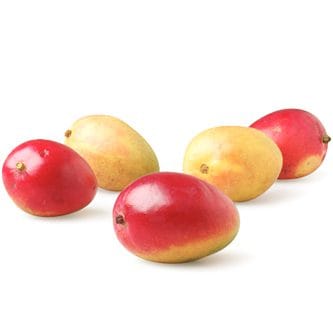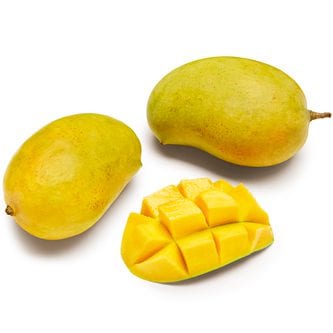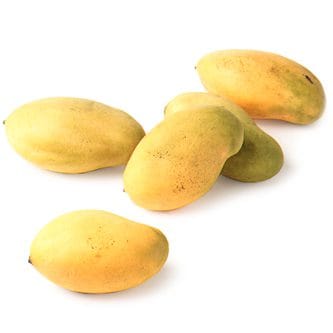Mango Madness! The Mango Varieties You’ve Got To Try
If you’ve ever spent time in a mango-growing region, you’ll know that the rest of the world is missing out on the most flavorful and delicious versions of this fruit. At FreshDirect, it’s a passion of ours to bring that one-of-a-kind experience to you.
There are many types of mangos, representing a variety of shapes and colors, from the popular green-red Tommy Atkins to luscious golden Champagne mangos. No matter which one you choose, it’ll be delicious during peak mango season. From roughly April to July, the tropical fruit is at its sweetest and juiciest.

We’re truly mango mad at FreshDirect. Come spring, you’ll find an array of fresh mango varieties on the site that you won’t find elsewhere. Among serious mango obsessives (there are many), we’re known as one of the best places where you can buy Indian mango varieties (like the Alphonso) and other special fruits from tropical growing regions. We work with farms in south Asia, the Caribbean, Mexico, Colombia, and beyond to source some of the worlds’ most incredible mango fruits.
To give you a better idea of the varieties of mangos out there, we’ve rounded up the ones you’ll find on FreshDirect. Just bear in mind that availability depends on seasonality and current sourcing. Many specialty varieties have very limited seasons. So if you see one, don’t wait to grab it!
All mangos are great for making smoothies, desserts, salsas, slaws, and salads. But often, the best way to enjoy them is by slicing one up and delighting in its pure, fresh taste. To know if your mango is ripe, give it a gentle squeeze: It should be tender and yield slightly to pressure, but not firm or mushy. Color is not always the best indicator of ripeness, especially with many specialty varies. Firm or hard mangos can be put in a sealed paper bag and left on the counter overnight to ripen.

Mangos on FreshDirect
Champagne mangos are small, delicately shaped mangos with golden yellow skins, and velvety flesh that has almost no fibrous texture. Only available from February to July, their exceptionally sweet flavor should be savored while it can. FreshDirect sources champagne mangos from our partners at Ciruli Brothers, who pamper their fruits by letting nature take the lead during the growth cycle, then putting them in the ideal conditions as they make their way to you.
Tommy Atkins mangos are the most popular variety in the US. These fruits are on the larger side and flaunt a distinctive reddish skin. On the inside, their flesh is firm and dense, with just enough fiber to give it some chewiness. That texture makes the Tommy Atkins ideal for chopping up and using in salads, salsas, and chutneys.
Among chefs, Alphonsos are often cited as a favorite. The season for them is short—just 6–8 weeks—starting in April. FreshDirect sources Alphonso mangos from our friends at Savani Farm, a family-owned and operated plantation located on 150 acres close to India’s Gir National Park. On the outside, Alphonsos have a pinkish blush, while inside, their saffron-colored flesh reveals itself to be buttery and exceptionally sweet, earning them the nickname “the king of mangos.”
 Kesar (a.k.a. royal Indian saffron)
Kesar (a.k.a. royal Indian saffron)
While Alphonso mangos are called the “kings,” kesar mangos have become known as the queens. These petite fruits are impossibly sweet and creamy, with an aromatic, almost floral flavor profile that is quite unlike any other variety. Kesars also come to us from Savani Farms, where they arrive a little bit later in mango season. One bite and you’ll understand just how distinctive and delicious real Indian mangos can be.
The olamangola is an Indian variety with a larger size and fiber-less flesh that provides a smooth and enjoyable eating experience. A coconutty flavor adds a unique twist to its taste profile. It exhibits profound sweetness, incredible aroma and flavor further enhance the overall experience. It can also be enjoyed while still green—in South Asia, unripe mangos are often turned into pickles.
Rounding out our selection of Indian mangos from Savani Farms is this lesser known, but equally distinctive variety. Named for a town in Andhra Pradesh, these mangos are smooth and almost pudding-like with an exceptionally sweet, honey-like flavor. They’re so sweet, in fact, that the large pores on their green-to-golden skin often seeps out sugars, leaving dark spots. In India, this sweet skin is often consumed too, along with the flesh.
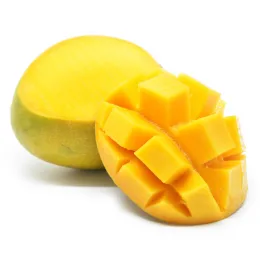 Jasmine
Jasmine
This cultivar of Indian origin has bright golden flesh. As its name suggests, it has an intoxicating and distinct floral aroma.
Francines are a Haitian variety famous for their perfumed aroma, juiciness, and rich, spicy flavor. This skin that covers their signature “S”-shape shifts from green to bright yellow as it ripens. Inside, Francines are meltingly soft and juicy, with dense flesh that is perfect for cutting and cubing. Their season lasts from March to August.
The Mingolo mango has gone from being almost unknown to one of the most demanded in recent years. These fruits from the Dominican Republic are sweet with green skin that ripens to a yellow color. Medium sized with just a small bit of fiber, they’re a must-try for lovers of tropical produce.
The Julie mango, also known as a St. Julian, is a favorite in Jamaica for its superb juiciness and rich, sweet flavor. The texture is softer, smoother, and less fibrous than other mango varieties, making it especially easy to love and a perfect addition to any fruit plate.
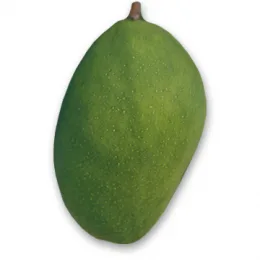
The Malika (or Mallika) mango is an Indian hybrid variety bred for its exceptional, dessert-like sweetness. The taste is creamy and bright, with notes of melon and citrus.
 Baby Mango
Baby Mango
Also known as a sugar mango or mango de azucar, these petite fruits are loved for their juiciness and extra-sweet flavor with complex tropical notes. This variety is unique to Colombia and is now available in the United States for the very first time.

Mango Recipes to Try
Mangos are an excellent addition to recipes both sweet and savory. Here are some of our favorite ways to use them.

